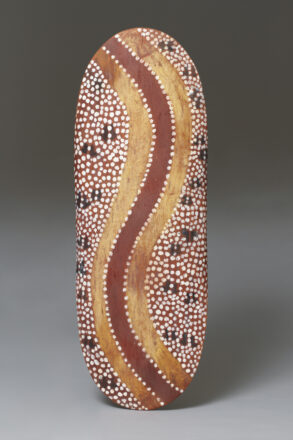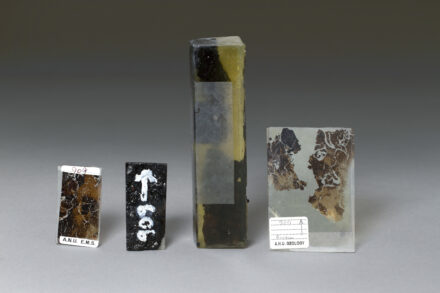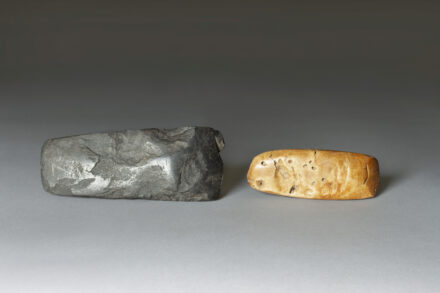
Article by Dr Louise Hamby
Research Fellow, Australian National University
This basket at a glance fits into a broader category of baskets made in eastern Arnhem Land for the past fifty years. It is part of a bigger story of Australian Indigenous creativity and the impact of those who came to Arnhem Land to bring Christianity and a different way of being-in-the-world. By examining the research surrounding the object there are characteristics that make this a special basket made by Ruby Gubiyarrawuy Guyula in 1998.
The majority of baskets made in Arnhem Land before the advent of missionaries in the 1920s did not look like this one. They were tubular in form and were constructed with the technique of twining. Horizontal elements were twisted around vertical ones with varying amounts of space between the rows. Colour other than the natural hue of the materials was obtained by brushing on ochres used in painting of bark, often in horizontal bands. A common feature in Gubiyarrawuy’s basket and those of earlier times is the use of Pandanus spiralis leaves.
The technique of coiling, involving stitching around a bundle of fibres, is now a common one. However, it was introduced through missionaries. They also encouraged women to make forms that could be easily used by their supporters in the south of the country. Key features included baskets with flat bottoms and firm handles for ease of carrying. When customers wanted colour in their products dyeing of fibre was encouraged. This was done with local plants. This basket has the natural dyed pandanus but begins to depart form the ideal mission basket. It has three coiled handles that are stitched to the body of the basket, making it a bit difficult to carry.
This feature and the form of the basket hint at a greater story behind the making of the baskets and its eccentric maker, Ruby Gubiyarrawuy Guyula. She was small in stature, big in energy and knowledge. As the balanda, (white person) whom she adopted as her sister or yapa, I was in a good position to gain some understanding about her work in fibre and her position within the community of Gapuwiyak. During the late 1990s, doing doctoral research, I worked with Gubiyarrawuy and others to try to understand not only the materials, morphology and making of baskets but their position in the cosmology of the region.
As a Djambarrpuyngu woman, Gubiyarrawy was an experienced ceremonial person and knew the stories of the Djang’kawu. These ancestral sisters were creator figures from eastern Arnhem Land. They came from the east in canoes to the shore and carried sacred baskets with them. This basket is one of several made in a canoe shape. She explained to me that this was a naku or canoe like the ones the Djang’kawu sisters had. The handles would be the position of the seating. This basket combines cultural beliefs with the practicality of a basket.
Further Reading
Hamby, L 2001, Containers of Power: Fibre Forms from Northeast Arnhem Land Australia, unpublished PhD Thesis, Australian National University, Canberra.



